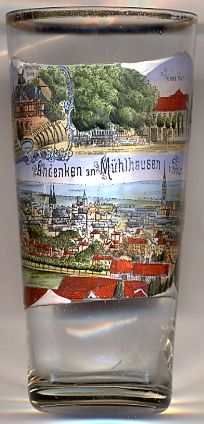

|
| DEUTSCHLAND | GERMANY |
| Bundesland: Freistaat Thüringen | Thuringia |
| Landkreis: Unstrut-Hainich-Kreis |
 Mühlhausen / Thüringen is situated at an elevation of 216 m at the river Unstrut in Germany's state of Thuringia. Mühlhausen is the administrative centre of
the Unstrut-Hainich district. The municipality has a population of about 36,200 (2008).
Mühlhausen / Thüringen is situated at an elevation of 216 m at the river Unstrut in Germany's state of Thuringia. Mühlhausen is the administrative centre of
the Unstrut-Hainich district. The municipality has a population of about 36,200 (2008).
Mühlhausen is one of the oldest towns in Thuringia. It said to have been fortified in 925, and is first documented in 967 as an Ottonian village. Its early importance is shown by the grant of privileges made to it by the German King Henry the Fowler (876–936), and by the Imperial Diet held here in 1135. Its period of glory was the 13th through the 15th century. During the Reformation, Mühlhausen became one of the chief seats of the Anabaptists. The radical reformer Thomas Müntzer preached in the Church of Saint Mary in 1525, and was captured in the vicinity and executed in the town. Johann Sebastian Bach was an organist in the Church of Saint Blaise in 1708 and 1709. Internal dissensions and injuries received during the Thirty Years' War (1618–1648) and the Seven Years' War (1756–1763) reduced Mühlhausen to unimportance. In 1802 it lost its independence and passed to Prussia. In 1807 it was attached to the Napoleonic kingdom of Westphalia, but in 1815 it again became part of the Prussian Province of Saxony. From 1944 to March 1945, a women's slave labor camp was directly outside Mühlhausen (a branch of the Buchenwald camp). The women were deported in April 1945 to Bergen Belsen. [Text adapted from http://en.wikipedia.org/wiki/Mühlhausen]
Friedrich August Stüler (1800–1865), one of the most influential German architects of the 19th century, was born in Mühlhausen. Among his many well-known works are the New Museum, Charlottenburg Palace, the New Synagogue and the Alte Nationalgallerie in Berlin, the university of Königsberg (now Калининград (Kaliningrad), Russia), the Royal Castle of Breslau (now Wrocław, Poland), the Friedenskirche (Peace Chruch) and the Orangerie at Potsdam, Hohenzollern Castle, Schwerin Castle, and the Hungarian Academy of Sciences in Budapest.
The former  Jakobikirche (church of St. James) [bottom picture: centre left]
was built between 1280 and 1363. The two towers were completed in 1418. After the Reformation, the church seems to have been in use only sporadically.
During the course of the 19th and 20th century almost the entire interior decorations were removed. Between 1992 and 2004 the structure was thoroughly renoved.
Since 2004 the building is used as Mühlhausen's municipal library.
Jakobikirche (church of St. James) [bottom picture: centre left]
was built between 1280 and 1363. The two towers were completed in 1418. After the Reformation, the church seems to have been in use only sporadically.
During the course of the 19th and 20th century almost the entire interior decorations were removed. Between 1992 and 2004 the structure was thoroughly renoved.
Since 2004 the building is used as Mühlhausen's municipal library.
The former  Marienkirche (church of Our Lady) [bottom picture: background right]
is Thuringia's second-largest church (after the cathedral of Erfurt).
The earliest mention of a church in this place is found in a document of 1180. Most of this older church was destroyed during a large fire in 1315, only the
north and south tower have remained.
Construction of the present church began in 1317 in Gothic style and lasted until the early 15th century.
Construction of the mighty west tower began in 1512 but was interrupted in 1517 during the Reformation.
Thomas Müntzer, one of the most prominent figures of the Peasants' War (1524–1525), was parish priest at this church.
After the Peasants' War the works were resumed but a large fire destroyed the provisional spire in 1689.
A new tower superstructure was built in 1690–1694, but was replaced in 1898–1903 by the present, neo-Gothic spire (86.7 metres)
under the supervision of the Prussian court architect Friedrich August Stüler; the spire is the highest of Thuringia.
Marienkirche (church of Our Lady) [bottom picture: background right]
is Thuringia's second-largest church (after the cathedral of Erfurt).
The earliest mention of a church in this place is found in a document of 1180. Most of this older church was destroyed during a large fire in 1315, only the
north and south tower have remained.
Construction of the present church began in 1317 in Gothic style and lasted until the early 15th century.
Construction of the mighty west tower began in 1512 but was interrupted in 1517 during the Reformation.
Thomas Müntzer, one of the most prominent figures of the Peasants' War (1524–1525), was parish priest at this church.
After the Peasants' War the works were resumed but a large fire destroyed the provisional spire in 1689.
A new tower superstructure was built in 1690–1694, but was replaced in 1898–1903 by the present, neo-Gothic spire (86.7 metres)
under the supervision of the Prussian court architect Friedrich August Stüler; the spire is the highest of Thuringia.
The top left picture on glass no. 2582 shows the
 Popperöder
Popperöder
The top right picture shows the
 Weißes Haus
Weißes Haus
![[scale]](lineal.jpg)